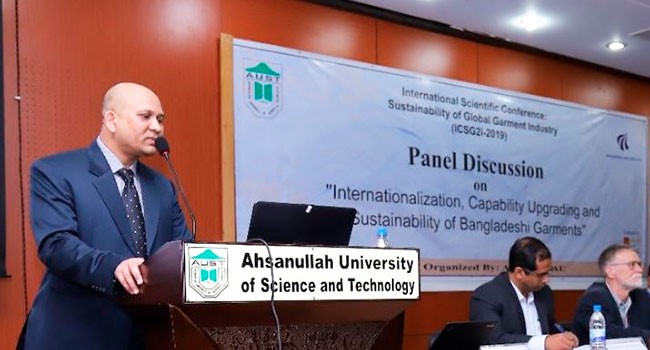Garment is the lifeblood of the Bangladeshi economy earning 83% of the country's total export revenue. However, the Bangladesh is struggling to keep its position as the world's second-largest exporter of garments after China. Associate Professor of International Business and Strategy Mohammad Bakhtiar Rana is one of the AAU researchers in the Danida funded project. He describes the situation as follows:
- Bangladesh faces intensive competition from countries like Cambodia, Vietnam, Myanmar and Ethiopia as global brands search for cheap labor, low cost location and shorter geographical distance. While foreign retailers continue to offer low price for sourcing, cost of production in Bangladesh is rapidly increasing, which is not only limited to labor but also involved with occupational health and safety (OHS) arrangement and cost of doing business. This condition poses a big challenge for Bangladeshi garment industry where firms do not tend to focus on managerial capability development and innovation across the activities in value chain.
International conference on ‘sustaining garments’
On March 7, 2019, Mohammad Bakhtiar Rana and his fellow researchers at Aalborg University, Professors Peter Hasle, Jan Vang and Asst. Professor Malek Maalouf had organized an international scientific conference on ‘sustaining garments’ in Dhaka, Bangladesh, together with Ahsanullah University of Science and Technology.
At a panel discussion, Rana as the chair presented his research findings and made dialogues with global retailers and policy makers. Participants in the panel discussion were a.o. European retailers such as Bestseller and H&M and their large suppliers in Bangladesh, government policy makers, local and international researchers and think-tank NGOs. Currently, Rana has been working on three research projects related to garment industry that focus on: 1) how and why local garment suppliers are locked-in the upgrading process and what role institutions and business system play in this regard, 2) why Bangladeshi suppliers internationalize to Ethiopia and how institutions, buyer’s business model and supplier’s entrepreneurial capability influence the internationalization process, and 3) how garment suppliers’ capability development is influenced by foreign buyers’ business model and governance in relational mechanism.
Suggestions for helping the industry
The panel discussion rounded up with some key suggestions where every panel member agreed that both international retailers, suppliers and the state should work together to prosper the industry. First of all, the focus should be made on upgrading the standard of management and international business education in the country, because educated workforce from the local institutions, which is relatively substandard at the moment, later makes knowledge and managerial contribution to the garment companies capability development and internationalization.
Second, firms should emphasis managerial capability development and focus on innovation in every point of value chain and export marketing. Third, Bangladeshi government should focus on policy development for strengthening collaboration between firms and higher education and research institutions in the country and abroad. Fourth, the panel agreed that all firms should focus on improving the occupational health and safety condition of the factories, which will eventually affect the productivity. Fifth, firms should take measures to develop brands for international markets.
Don’t rely on cheap labour only
In Mohammad Rana’s opinion Bangladeshi garment-companies cannot sustain for long if they continue to rely on cheap labour only. They should instead opt for ensuring other competitive advantages in the supply chain, design and production, such as innovation in developing special type of fabric, using green technology in production and recycling, own brand development for international markets etc. While they should also emphasize the development of managerial capability and international business skills.
- If this industry relies only on cheap labour, as soon as foreign retailers find an alternative competitive location, they would begin to move to that location. History says, garment industry has been moving from one location to another depending on the availability of factors of production, says Rana.
Read about the panel discussion in the Bangladeshi newspaper The New Nation.
Contact
Associate Professor Mohammad Bakhtiar Rana
Department of Business and Management, Aalborg University
Phone: +45 9940 8231
Email: mbr@business.aau.dk
Communications officer Torben Haugaard Jensen
Department of Business and Management, Aalborg University
Phone: +45 9940 3072
Email: thj@business.aau.dk

